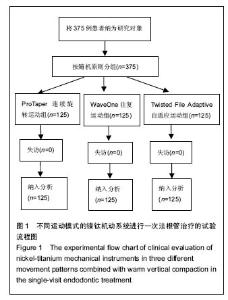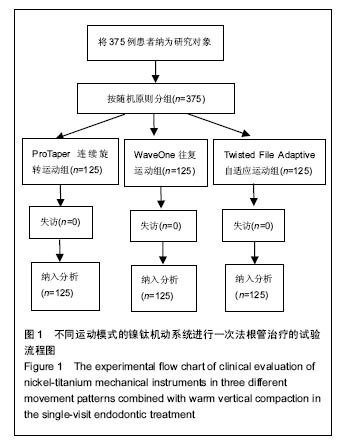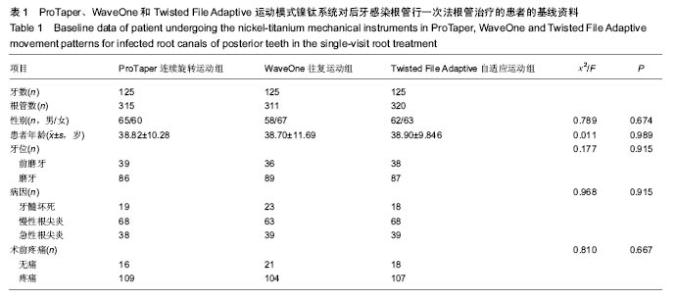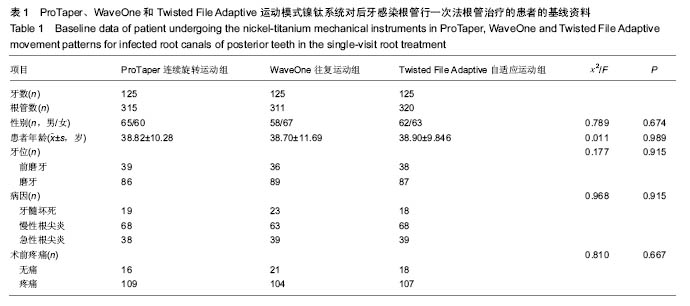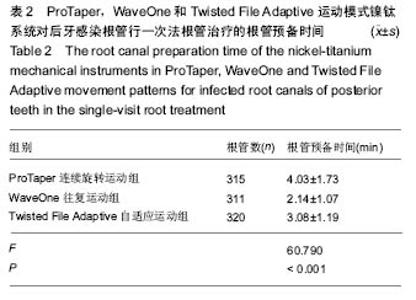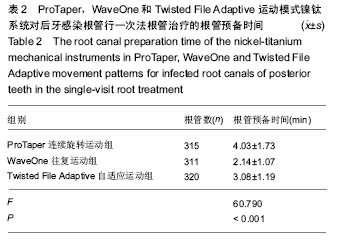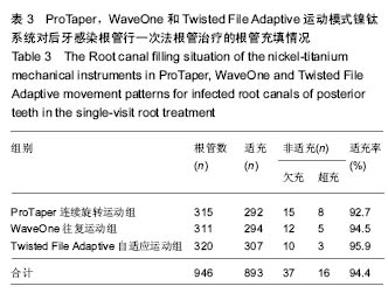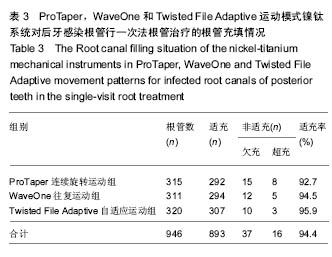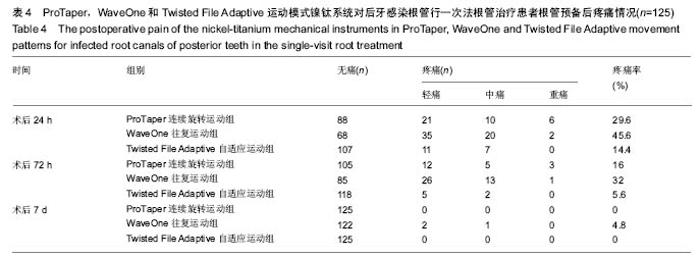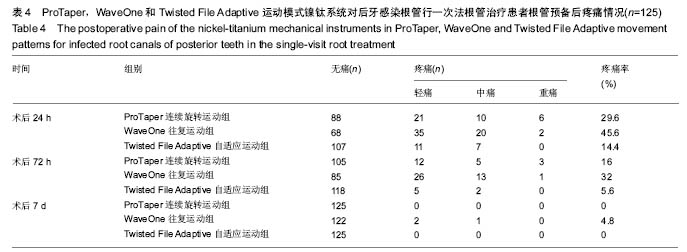| [1]步江,尼娜,聂彬,等.热牙胶根管充填技术对下颌第二磨牙C形根管充填效果的研究[J].中华临床医师杂志(电子版), 2013, 7(24):11838-11841.[2]林南雁,姜毅.一次性根管治疗对老年人感染根管的疗效[J].中国临床保健杂志,2010,13(2):135-136.[3]吴丽华.一次性根管治疗慢性根尖周炎和牙髓炎疗效观察[J].中国基层医药,2012,19(18):2789-2790.[4]孙玉亮,梁学萍,赵今.比较一次法与多次法根管治疗术治疗慢性牙髓炎?根尖周炎疗效的系统评价[J].牙体牙髓牙周病学杂志, 2011,21(8):452-458.[5]罗琳,刘亚君.一次法根管治疗急性牙髓炎的疗效[J].中国实用医刊,2012,39(7):114-115.[6]沙琳.根管治疗中一次法与多次法术后疼痛的临床观察[J].中国实用医药,2015,10(13):115-116.[7]Kirchhoff AL, Fariniuk LF, Mello I. Apical extrusion of debris in flat-oval root canals after using different instrumentation systems. J Endod. 2015;41(2):237-241.[8]黄香,陈俊敏,何升腾.老年人死髓牙一次性根管治疗的临床疗效评价[J].中华老年口腔医学杂志,2014,12(2):208-210.[9]樊明文,周学东.牙体牙髓病学[M].4版.北京:人民卫生出版社, 2012:267.[10]梁学萍,孙玉亮,赵今.AH plus 与碧兰两种根充糊剂在根管治疗中的临床疗效评价[J].新疆医科大学学报,2014,37(9): 1164-1166.[11]李荣华,朱敏,葛久禹.不同预备方法对根管预备后约诊间痛的影响[J].口腔医学,2012,32(3):162-166.[12]Schneider SW. A comparison of canal preparations in straight and curved root canals. Oral Surg Oral Med Oral Pathol. 1971; 32(2):271-275.[13]郝静华,张志宏,曾莉,等.三种根管预备器械在磨牙根管治疗中的临床应用研究[J].安徽医学,2013,34(2):131-133.[14]林南雁,金建秋,姜毅.机用镍钛旋转器械根管预备临床观察[J].中国医刊,2012,47(8):81-83.[15]伍婉翠,陈广盛. 三种根管预备器械预备根管根尖碎屑推出量和根管清理能力的比较[J].中国组织工程研究, 2015,19(34): 5443-5447.[16]叶敏,林金伏,刘河娣,等.优化椅旁护理配合在牙髓病治疗中的应用[J].现代医院,2011,11(2):20-21.[17]Arias A, de la Macorra JC, Azabal M, et al. Prospective case controlled clinical study of post-endodontic pain after rotary root canal preparation performed by a single operator. J Dent. 2015;43(3):389-395. [18]王镇.机用镍钛器械TF和Protaper用于根管治疗的临床比较[J].临床医学口腔杂志,2012,28(8):479-480.[19]Imfeld TN. Prevalence and quality of endodontic treatment in an elderly urban population of Switzerland. J Endod. 1991; 17(12):604-607.[20]Cruz Junior JA, Coelho MS, Kato AS, et al. The Effect of Foraminal Enlargement of Necrotic Teeth with the Reciproc System on Postoperative Pain: A Prospective and Randomized Clinical Trial. J Endod. 2016;42(1):8-11.[21]Negm MM. Effect of intracanal use of nonsteroidal anti-inflammatory agents on posttreatment endodontic pain. Oral Surg Oral Med Oral Pathol. 1994;77(5):507-513.[22]杨俊,魏欣,孙世尧.Pathfile和Protaper联合预备磨牙弯曲根管的临床评价[J].临床口腔医学杂志,2015,31(1):34-36.[23]Li H, Zhang C, Li Q, et al. Comparison of cleaning efficiency and deformation characteristics of Twisted File and ProTaper rotary instruments. Eur J Dent. 2014;8(2):191-196.[24]王吓勇,彭彬,王娇英,等.机用ProTaper锉临床折断情况分析[J].广东牙病防治,2011,19(4):177-180.[25]王安阳,史春,宋其义,等.TF镍钛器械根管成形效果的锥束CT研究[J].牙体牙髓牙周病学杂志,2014,24(4):231-234.[26]贾琳,仪虹,刘志杰,等.WaveOne器械预备C型根管成形效果的CBCT研究[J].口腔医学研究,2014,30(11):1069-1076. [27]da Frota MF, Espir CG, Berbert FL, et al. Comparison of cyclic fatigue and torsional resistance in reciprocating single-file systems and continuous rotary instrumentation systems. J Oral Sci. 2014;56(4):269-275.[28]赵旭,孙莹,唐宇欣,等.Waveone单支锉镍钛系统的研究进展[J].医学美容医学(中旬刊),2014(6):583-584.[29]王燕,郭嘉,王茜,等.比较两种镍钛器械在不同运动模式下预备根管后牙根微裂纹的发生率[J].牙体牙髓牙周病学杂志,2015, 25(9):549-553.[30]Gambarini G, Gergi R, Naaman A, et al. Cyclic fatigue analysis of twisted file rotary NiTi instruments used in reciprocating motion. Int Endod J. 2012;45(9):802-806.[31]Gergi R, Osta N, Bourbouze G, et al. Effects of three nickel titanium instrument systems on root canal geometry assessed by micro-computed tomography. Int Endod J. 2015;48(2): 162-170.[32]Kirchhoff AL, Fariniuk LF, Mello I. Apical extrusion of debris in flat-oval root canals after using different instrumentation systems. J Endod. 2015;41(2):237-241.[33]Gambarini G, Testarelli L, De Luca M, et al. The influence of three different instrumentation techniques on the incidence of postoperative pain after endodontic treatment. Ann Stomatol (Roma). 2013;4(1):152-155.[34]Bürklein S, Schäfer E. Apically extruded debris with reciprocating single-file and full-sequence rotary instrumentation systems. J Endod. 2012;38(6):850-852.[35]杨雨虹,唐倩.往复式运动镍钛器械的研究进展[J].中华口腔医学研究杂志(电子版), 2015,9(4):337-339.[36]鲍洪源,朱羽佳,龚慧. ProTaper机用镍钛系统在156例根管预备中的临床研究[J].临床口腔医学杂志,2012,28(5):282-283.[37]黄玉球.热牙胶充填与冷牙胶侧方加压的根管充填效果比较[J].现代中西医结合杂志,2014,23(9):965-967. |
